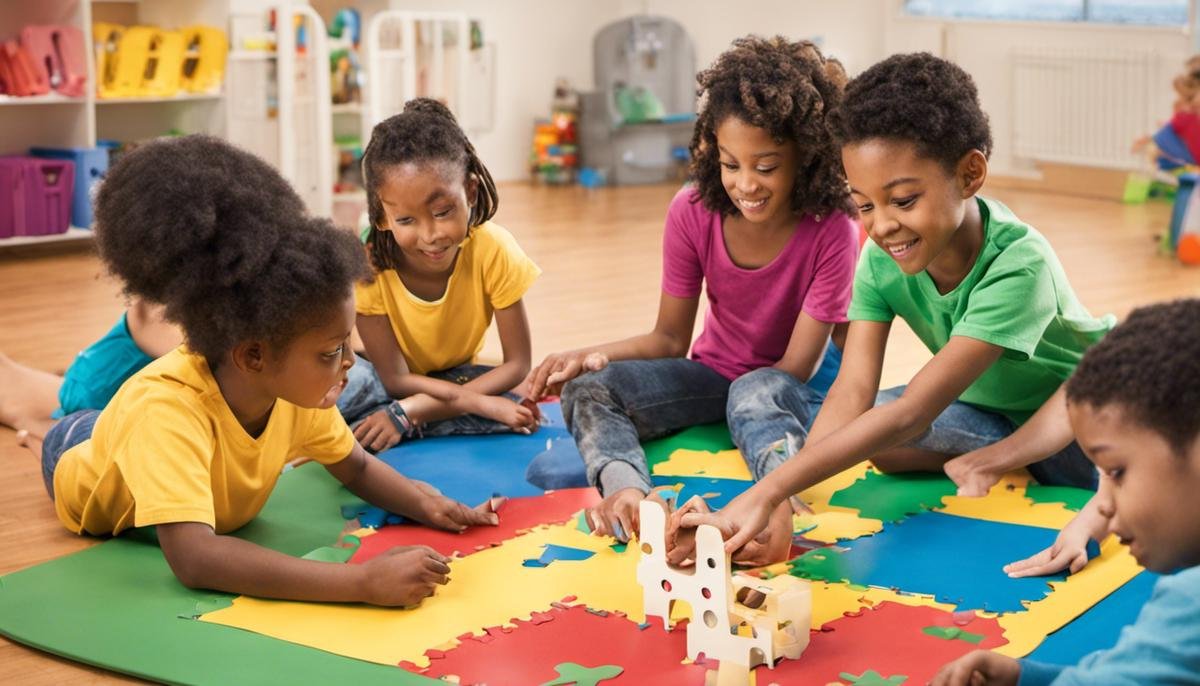
In the vast expanse of human nature, the intriguing, complex world of Autism stands as a significant chapter that many individuals and their loved ones actively navigate daily. Autism Spectrum Disorder, characterized by its unique behavioural patterns, communication difficulties, and distinctive social interactions, offer a profound glimpse into a distinct perspective of life. This discourse aims to provide a better understanding of this broad spectrum, its myriad manifestations in every child, and the process of Autism diagnosis – encapsulating the critical role of professionals, evaluations, and the poignant emotions involved. Additionally, we delve into various therapeutic interventions, the influential role of family and community, strategies to make school and social life more inclusive for an autistic child and, importantly, planning for a promising future.
Understanding Autism
Title: Understanding Autism: Recognizing the Key Indicators in Child Behavior
Understanding a child’s behavior can not only be intriguing but challenging as well. Every family’s journey with raising children is indeed unique and sometimes walking along unfamiliar paths like identifying autism symptoms can be emotionally stirring. If you find yourself in those shoes, it’s important to remember that resources, support, and guidance are available to help you navigate this journey.
In the realm of child development, autism spectrum disorder (ASD) has been a significant focus for many years due to its increasing prevalence. Being aware of the key indicators of autism in child behavior can facilitate early detection and intervention, fostering the holistic development of a child.
First and foremost, autism is characterized by challenges with social interaction and communication.
A child with autism might show less interest in other people or may struggle to look at people directly. They may have difficulty interpreting others’ emotions or expressing their own, exhibiting minimal facial expression or tone variation. Key to remember here is that these children aren’t being intentionally avoidant or indifferent but are finding navigating social nuances more challenging than their peers.
Speech-related delays or anomalies are also significant indicators of autism.
Children with autism may begin speaking later than their peers, and when they do start, their speech might exhibit unusual rhythms or repetitive patterns like echolalia—repeating words or phrases they’ve heard. They might struggle with metaphor and innuendo, finding literal interpretations more comfortable.
Furthermore, children with autism often have trouble handling sensory input.
They may become overwhelmed by loud noises, intense lights, or chaotic environments. Some might be hypersensitive to certain textures or tastes, resulting in restrictive eating habits or clothing preferences.
A child with autism also might display a strong preference for routine and predictability.
They may insist on eating the same foods, wearing the same clothes, or following the same daily schedule. Unexpected changes in routine can trigger heightened anxiety or distress.
Lastly, intense fascination with a particular topic or unusual attachment to specific objects can also be a symptom of autism.
If a child is consistently overly-focused on certain subjects or things, to the exclusion of other activities, it may signal they are on the autism spectrum.
Deciphering these cues in children’s behavior can be challenging and confusing. Yet, it’s essential to understand that these behaviors are part of a spectrum, and they will look different in every child. Not every child with autism will present the entire range of symptoms or experiences. Parents or guardians who note a combination of these signs should seek professional advice for further evaluation and guidance.
It’s critical to remember that early intervention can make a significant difference. A diagnosis of autism is not a bleak verdict but rather an opportunity to understand your child and their unique way of experiencing the world. With targeted support and therapies, children on the autism spectrum can not only improve in areas of difficulty but thrive, living a fulfilling life to their full potential.

Diagnosis Process
The Complete Guide to the Autism Diagnosis Journey
If parenting is a journey, then an autism diagnosis sets an entirely unanticipated path. Although challenging, this pathway is merely different, not less than. Yes, the path has its bumps, but it is also filled with much hope, success, and joyful moments.
Embarking on the autism diagnosis journey can be daunting. There’s a lot to discern, and much remains genuinely unknown, even to seasoned professionals. Often, apprehension arises from not knowing what to expect. To help ease this process, we’ll explain the aspects that typically accompany an autism diagnosis.
One longtime proverb says: “knowledge is power.” This rings true for an autism diagnosis, just as with any significant life event. The more we understand, the better prepared we are and the lesser fear we hold.
Post identification of initial signs which could range from challenges with social interaction to an intense fascination with a specific topic, the next step would be a formal diagnosis. The formal diagnosis typically starts with a developmental pediatrician, psychologist, or psychiatrist. These professionals utilize several tools such as the Autism Diagnostic Observation Schedule (ADOS) or the Autism Diagnostic Interview-Revised (ADI-R) to provide an accurate diagnosis.
Parents should anticipate several interviews and assessments which will help the professional understand the child’s developmental history and behavior in various circumstances. These may seem intimidating, but these evaluations are designed to capture a holistic understanding of your child to tailor the necessary support.
Parents and caregivers are integral participants in the diagnosis process. Their observations and insights are every bit as valuable as clinical assessments. Parents may be asked for detailed anecdotes about their child’s behavior, their developmental milestones, and their unique strengths and challenges.
During this phase, it’s key to forge a transparent and collaborative relationship with the medical team. They are allies in this process. Though it can be daunting, remember – they’re here to advocate for your child’s optimum growth and development. Each step taken is a collaborative act of love, devotion, and commitment to your child.
Depending on the age and abilities of the child, it can also be helpful to encourage their participation. Indeed, kids often understand more than we give them credit for! Involving the child can help them gain a sense of agency and belongingness.
Post-diagnosis, your medical professional will discuss the findings, potential treatment options, and therapies. Remember, every child on the autism spectrum is different; hence the treatment plan will be customized to their unique needs. Parents can expect a mix of behavior therapy, communication therapy, and family therapy.
Know that an autism diagnosis is not a limitation; it’s merely a different path. Parents and children travel this path together, hand-in-hand, growing with each step. The journey may seem challenging initially, but remember this – it’s not about ‘fixing’ your child; it’s about understanding them better. And with understanding comes compassion, advocacy, and an environment that they can thrive in. All children have a constellation of talents, strengths, and capabilities, and kids with autism are no different.
At the end of the day, our goal as parents is to help our children become the best version of themselves, learning to navigate the world with resilience, grit, and grace. This journey can be overwhelmingly beautiful, with its highs and lows. Always remember, you’re not alone on this path; an entire community of fellow parents and professionals are here with open arms, ready to support and guide on this adventurous journey.

Therapies and Interventions
Knowledge and Understanding of Preferred Therapies and Interventions for Autism
As parents and caregivers, unraveling the best course of treatment for children diagnosed with Autism can be a walk through a labyrinth. Settling on the most constructive therapies and interventions requires us to understand better how these treatments work and their potential benefits for our little ones.
A variety of therapies and interventions can be beneficial to children with Autism. Let’s delve a bit further into these incredible resources together.
Behavioral and Communication Approaches
Applied Behavior Analysis (ABA) is an intervention that has shown promising results in children with Autism. It encourages positive behaviors while discouraging harmful or adverse behaviors, offering a personalized therapeutic approach. The premise is simple but profound: rewarding positive behavior often reinforces and increases that behavior.
On the other hand, approaches like Verbal Behavior Therapy (VBT) can improve communication abilities. VBT uses ABA principles to motivate the child to say or indicate what they want or need. Notably, Speech and Language Therapy can also be enormously helpful for those speech-related delays or anomalies, employing strategies to promote better verbal, nonverbal, and social interaction skills.
Sensory Therapies
Sensory therapies, like Occupational Therapy (OT), are instrumental with sensory sensitivities. OT tips tailored to children with Autism may include activities that encourage sensory integration or strategies to manage daily activities better. For instance, if your child struggles with brushing teeth or dressing up, an occupational therapist may share tips or demonstrate methods to make these routine tasks more enjoyable and less stressful.
Maximizing Routine and Predictability
Given that children with Autism prefer routine and predictability, interventions that boost this aspect can aid their overall skill development. Picture Exchange Communication System (PECS) and visual schedules provide structure, helping kids predict and follow a routine. They also encourage communication in nonverbal kids.
Interest-Based Learning
Training in an area of interest can be highly motivating and improve social and conversational skills for children with Autism. For instance, if a child is fascinated by dinosaurs, they could learn math, reading, or social skills using dinosaurs as the primary focus. This interest-based approach often results in tremendous progress.
Building Communities
Families, educators, and therapists forming supportive communities play an essential role in the autism journey. Joining local Autism support groups or online communities can provide respite, resources, and a platform to discuss therapeutic approaches. They can also help disseminate the idea that Autism isn’t a limitation, just a different path.
Therapies and interventions for Autism aren’t one-size-fits-all, and it may need time, patience, and trials to discover what works best for your child. But let’s remember, our children are not defined by their Autism; they are individuals with unique talents and capabilities. As we navigate this journey, let’s be the beacon of compassion, advocacy, and inclusion they need. After all, every child deserves the opportunity to sparkle in their own resplendent way.

The Role of Family and Community
Fostering A Nurturing Home and Community for Autism
When navigating the path of nurturing an individual with autism, it’s vital to remember that the journey doesn’t end with the diagnosis. Parents, family members, and the broader community all play a significant part in supporting and advocating for the individual in creating a more inclusive environment.
One common challenge faced during the autism diagnosis journey is misconceptions and societal stereotypes around what autism is—and what it isn’t. Widespread education and understanding are critical in breaking down these barriers. It benefits not only the individual diagnosed but everyone around them, making it easier for the community to share empathy and lend support.
The process of formal diagnosis involves various steps and professionals, including psychologists, behavior analysts, and speech and language therapists. Parents and caregivers play an integral part in this process, providing valuable insights about the child’s development and behavior in their natural environments.
Just as crucial is encouraging the child’s participation and agency throughout the process. By involving them in an age-appropriate manner, it boosts their self-confidence and helps them understand their unique strengths and challenges.
Post-diagnosis, discussions about treatment options and therapies become imperative. A group of therapies known as Applied Behavior Analysis (ABA) often serves as the foundation for treatment. Verbal Behavior Therapy (VBT), Speech and Language Therapy, and Occupational Therapy (OT) are among others that help individuals with communication, life skills, and coping mechanisms.
The Picture Exchange Communication System (PECS) enables traditional and non-verbal communicators to express their needs effectively. Visual schedules, another tool, can provide structure and routine, often loved by individuals with autism. Remember, these tools are not one-size-fits-all and may require customization according to individual preferences and needs.
In tandem with structured therapies, interest-based learning stands out as an innovative approach to harness an individual’s fascinations into productive learning experiences. It’s all about celebrating their uniqueness and nurturing their talents.
Perhaps an often-overlooked, essential factor in supporting an individual with autism lies within the heart of the community—compassion and advocacy. An inclusive and welcoming environment works wonders for the growth and wellbeing of such individuals. Encouraging this perspective shifts the perception of autism from a limitation to a different, equally valid path.
The journey of parenting and working with a child with autism can be enlightening and rewarding, but it can also be challenging and isolating at times. One way to alleviate this isolation is to become part of a larger community – a network of parents, professionals, educators, and others who share similar experiences. These networks can provide support, offer advice, and create opportunities for individuals with autism to socialize in a safe and understanding space.
Everyone deserves to flourish and grow, and individuals with autism are no exception. They have unique strengths, talents, and capabilities that, when recognized and nurtured, can make them powerful contributors to society. All they need is caring support and understanding from their families, communities, and society at large. So, let’s pledge to do just that—it’s not just about supporting an individual with autism; it’s about enriching our lives and learning more about and from these extraordinary individuals we’re privileged to know.

Navigating School and Social Life
Every child is unique, and this is especially true for kids on the autism spectrum.
As parents, caregivers, teachers, and friends, our role is not just to support their specific needs, but also to ensure they thrive both acadically and socially. To do this effectively, we need to put in place strategies that are tailored to their individual strengths, talents, and needs.
One notable strategy is implementing educational modifications. This approach is all about tweaking the learning environment, strategies, or methods to suit the specific needs of an autistic child. For instance, you can modify assignments to focus on the child’s areas of interest, or use visual aids to illustrate abstract concepts. Sometimes, simply allowing extra time to complete tasks can make a significant difference, reducing pressure and frustration.
Working with educators who understand autism and its impact on learning is crucial. They can highlight the child’s strengths, engage them in activities that hold their interest, and provide a safe and supportive learning environment where they feel respected and understood. This can lead to significant improvements in academic engagement and outcomes.
When we turn our focus to social support, it’s essential to remember that autistic kids often struggle to understand complex social cues. Social stories are a great tool to guide them through various social situations. These are short descriptions of a particular situation, event or activity, which include specific information about what to expect and why.
Role-playing activities are also excellent tactics to practice different social scenarios. This practice provides a safe space to learn and understand various aspects of communication such as tone of voice, facial expressions, and body language.
Fostering strong peer relationships is another integral aspect of social support. Encouraging involvement in group activities, clubs or sports can be a significant step towards helping autistic kids feel accepted and included. It’s rewarding to see them overcome hurdles, make friends, and see a boost in their self-esteem.
Another challenging but crucial part of supporting an autistic child socially is addressing bullying. Advocating for awareness and fostering acceptance at school and the broader community is key here. Open discussions about autism, empathy, and acceptance can go a long way towards combating stigma and negative behaviors.
At home, creating a predictable, structured environment can provide a comforting sense of routine and order. A visual daily schedule, for instance, can help an autistic child understand what’s coming next, reducing anxiety around transitions or changes.
To round off, the journey of raising and supporting an autistic child acadically and socially is layered, but richly rewarding. As we navigate this path, let’s celebrate each small win, and continue to create environments at home, school, and in the community where every child’s unique abilities shine. We all have the chance to play our part in cultivating an inclusive society that recognizes and applauds the distinct strengths and talents of those on the autism spectrum.
Remember, it’s not about changing the child to fit into society, but rather, helping society make room for the beautiful diversity that each child brings. With love, knowledge and action, we all become better versions of ourselves through the meaningful relationships we build with children on the autism spectrum.

Planning for the Future
Planning for the future with autism is a journey, one that requires a unique blend of patience, understanding, and knowledgeable decision-making. Tackling this as parents starts with ensuring the child has a robust support system where everyone is on the same page. This includes schooling and ensuring the unique needs of children on the autism spectrum are met.
Education lies at the heart of progress. This includes not only from a professional perspective but also from the parents and family. All too often, there’s a disconnect between learning at school and home. Implementing educational modifications can make a world of difference. Educators trained to understand and nurture the potentials of autistic students can make the school experience much more fruitful and less stressful.
Speaking of educators, their role extends beyond typical teaching. They can additionally act as strong pillars of support. With their distinctive position, they can use their influence positively to encourage peer relationships and healthy interactions among the children. One innovative way this can be done is through social stories and engaging role-playing activities. These methods can offer autistic children a deeper understanding of social cues and interactions while promoting diversity and acceptance among their peers.
Bullying, unfortunately, is a reality many children with autism may face. The school being a primary environment for such incidents, education again comes back into the mix. Promoting awareness and acceptance at schools is paramount. This is not a heroic act but a basic human right to every child. Every kid deserves to learn and grow in a loving and supportive environment.
As important as school is, it’s only one part of a child’s life. Home is where they feel safest, and creating a predictable, structured environment can prove beneficial. It caters to their love for routine and predictability. Having fixed time for meals, homework, and even leisure can help the child understand, anticipate, and prepare for what’s to come.
Yet while routine is key, it’s also crucial to celebrate spontaneity and uniqueness. Every child with autism is unique, having their own set of talents and interests. Instead of dwelling on what they struggle with, celebrate what they excel at. Encourage them to engage in activities they have an interest in, and you might just unveil genius in those areas.
Finally, at the heart of it all, remember it takes a village to raise a child, and even more so for a child with autism. Nurture and build an environment of inclusivity and acceptance, not just at school or at home, but also in your neighborhood and community.
Planning for the future while living with autism doesn’t quite fit the common mold. Nevertheless, it’s beautiful in its uniqueness. After all, the essence of life lies in diversity, and it’s through the lenses of our differences that we learn how colorful life can be. So as we walked together with every child on this journey, let us remember this: autism isn’t a box of limitations but a release into a sky full of different colors and capabilities.

Living with autism is journey that is unique as well as challenging, yet filled with infinite possibilities. Preparing for the long-term aspects such as adulthood transitions, career options, and independent living, it becomes imperative to set realistic and meaningful life goals for an autistic child. The goal remains not to fit the individual into societal norms, but to shape a world that recognizes and values their exceptional abilities, ensuring they lead a fulfilling, independent life. Our concerted efforts as a society will eventually enhance our understanding of Autism, fostering a world that not just tolerates but appreciates the distinct human variance.




